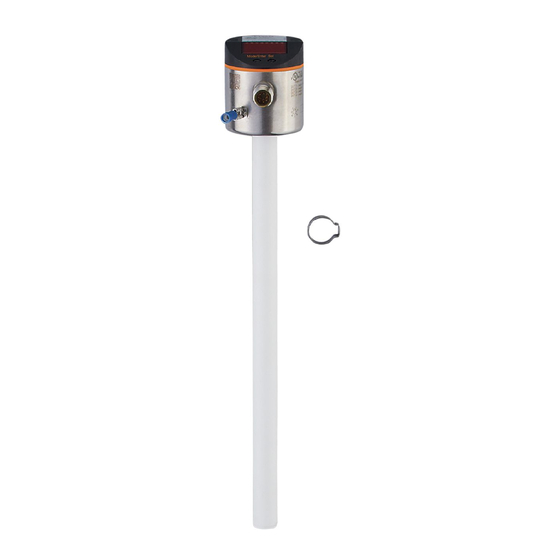
Table of Contents
Advertisement
Advertisement
Table of Contents

Summarization of Contents
Preliminary note
Symbols used
Explains symbols and their meanings for understanding instructions.
Functions and features
Application area
Describes where the unit is suitable for use and its intended purpose.
Restriction of the application area
Lists limitations and unsuitable applications for the unit.
Getting started
Example configuration 1
Provides a step-by-step setup example for a specific scenario.
Example configuration 2
Provides a second setup example for a different scenario.
Function
Measuring principle level
Explains how the level is measured using the capacitive principle.
Measuring principle temperature
Explains how temperature is measured by the unit's sensor.
Operating principle / features of the unit
Explains overall operational principles and the unit's output capabilities.
Operating modes
Details the different operating modes available for the unit.
Mounting
Notes on installation instructions for operation with overflow prevention
Details specific installation requirements when using overflow prevention.
Installation instructions for operation without overflow prevention
Details installation guidelines when overflow prevention is deactivated.
Installation in the inactive zone
Specific installation instructions for mounting the sensor in the inactive zone.
Installation in the active zone of the probe
Specific installation instructions for mounting the sensor in the active zone.
Other installation notes
Provides additional installation guidelines and considerations.
Marking of the installation height
How to mark and ensure the correct installation height for the sensor.
Parameter setting
Parameter setting in general
General steps and procedures for setting parameters on the unit.
Basic settings
Covers fundamental parameter configurations for the unit.
Assign process values to outputs [SEL3] / [SEL4]
How to assign level or temperature to specific outputs.
Assign process value to display [SELd]
How to select which process value is shown on the unit's display.
Define unit of measurement for level [uni.L]
Sets the unit (cm or inch) for level measurement indication.
Set unit of measurement for temperature [uni.T]
Sets the unit (°C or °F) for temperature measurement indication.
Set the offset [OFS]
Configures an offset value for accurate level indication from the tank bottom.
Set the medium [MEdI]
Selects the type of medium for accurate measurement and sensitivity adjustment.
Set the overflow prevention [OP]
Configures the position and activation of the overflow prevention feature.
Adjust the overflow prevention [COP]
Details the procedure to adjust the overflow prevention to the installation situation.
Setting of output signals
Configures the behavior and functions of the unit's switching outputs.
Set output function [oux] for OUT1...OUT4
Assigns switching functions (hysteresis, window) to outputs OUT1 through OUT4.
Define the switching limits [SPx] / [rPx] (hysteresis function)
Sets the ON and OFF points for hysteresis switching functions.
Define switching limits [FHx] / [FLx] (window function)
Sets the upper and lower limits for window switching functions.
Set set delay [dSx]
Configures delays for output switching actions to occur.
Set reset delay [drx]
Configures delays for output reset actions to occur.
Define switching logic [P-n]
Sets the switching logic (e.g., PnP, nPn) for outputs.
Define output response in case of fault [FOUx]
Sets how outputs behave and react when a fault is detected.
Configure display [diS]
Controls the display behavior, such as switching it on or off.
Reset all parameters to factory settings [rES]
Resets all configured parameters back to their original factory defaults.
Operation
Operating indicators
Explains the meaning of different LEDs, numerical displays, and status indications.
Read the set parameters
Describes the procedure to view the currently configured parameters of the unit.
Read/reset extreme value memory for temperature
How to access and clear the stored minimum and maximum temperature values.
Fast selection level / temperature
Allows quick switching between displaying level and temperature values.
Error indications
Lists possible error codes, their causes, and recommended troubleshooting measures.
Output response in different operating states
Describes how the unit's outputs behave in various operational states like initialization or fault.
Technical data
Setting values [OFS]
Provides the setting ranges and step increments for the offset parameter.
Setting ranges switching limits for level
Lists the adjustable ranges and step increments for level switching points.
Setting ranges switching limits for temperature
Lists the adjustable ranges and step increments for temperature switching points.
Setting values [OP]
Provides specific values for setting the overflow prevention (OP) position.
Calculation aids [OP]
Offers formulas and examples to help calculate the correct OP setting.
Definition "from the cover" for OP
Specific calculation method for determining the OP position from the tank cover.
Definition "from the bottom" for OP
Specific calculation method for determining the OP position from the tank bottom.
Maintenance / cleaning / change of medium
Maintenance information for operation without overflow prevention
Specific maintenance notes and reinitialization requirements without overflow prevention.
Applications
Storage tank
An application example for level control and monitoring in a storage tank.
Pumping station
An application example for level control in a pumping station.















Need help?
Do you have a question about the LT8022 and is the answer not in the manual?
Questions and answers